My Journey with Sublimation on Cotton: Tips & Techniques
Master sublimation on cotton with my expert techniques. Learn now and create vibrant designs!
Sublimation printing offers vibrant, durable designs, but it’s typically used with polyester fabrics. Many wonder if high-quality sublimation on cotton is possible. This guide explores the principles, innovative methods, and troubleshooting tips for sublimating cotton.
What is Sublimation on Cotton?
Sublimation printing is when heat transfers dye onto materials such as fabric, paper, or plastic. The term “sublimation” refers to the transition of the dye from a solid to a gas state without passing through a liquid state. This transformation allows the dye to penetrate the fibers of
How Does Sublimation on Cotton Work?
Sublimation works best on polyester because the dye bonds with its fibers. Cotton lacks this property, so prints on 100% cotton often look dull or fade quickly with standard sublimation methods.
Overcoming the Challenge: Special Techniques and Materials
To successfully sublimate on cotton, several special techniques and materials can be employed:
- Polyester Coating Sprays:
- These sprays are designed to create a polyester-like surface on cotton fabrics. By applying this spray, you can make a receptive layer on the cotton that allows the sublimation dye to bond effectively. This technique can help achieve vibrant prints on cotton.
- Sublimation Transfer Paper:
- Another popular method is using sublimation transfer paper designed for cotton. This special transfer paper has a coating that can adhere to cotton fibers. During the heat press process, the sublimation dye transfers from the paper to the layer, bonding with the cotton fabric.
- Polyester Blends:
- Using cotton-polyester blend fabrics can also be an effective way to sublimate on cotton. Fabrics with a higher polyester content (typically at least 40% polyester) will yield better sublimation results. The polyester fibers in the blend bond with the dye, while the cotton fibers provide the desired texture and comfort.
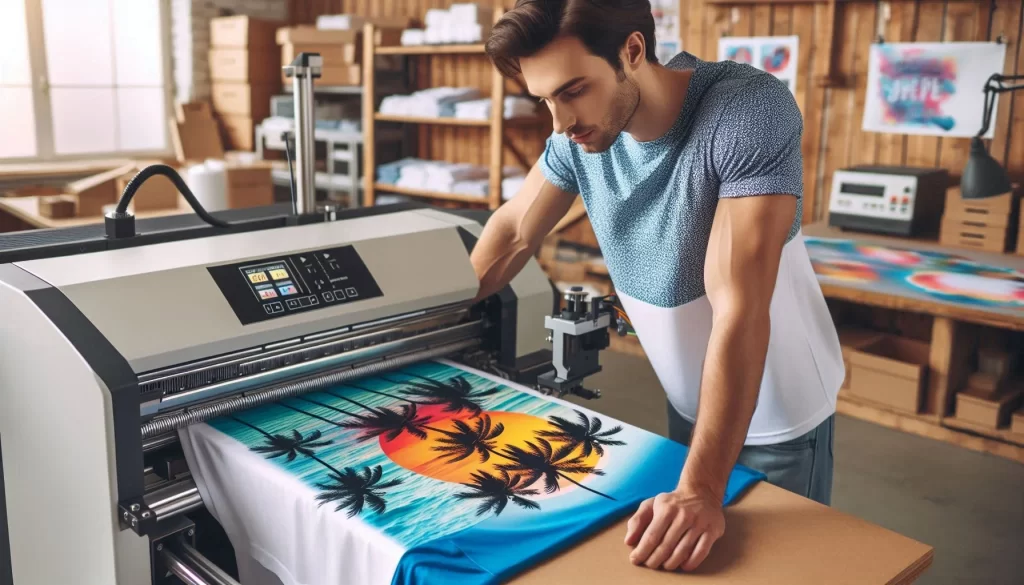
The Sublimation Process on Cotton
Here’s a step-by-step overview of the sublimation process on cotton using the above techniques:
- Preparation:
- Choose a high-quality cotton fabric or a cotton-polyester blend.
- Using a polyester coating spray, evenly apply the spray to the fabric and let it dry completely.
- Printing the Design:
- Print your design onto sublimation transfer paper using sublimation inks and a compatible printer. Make sure to print the design in reverse (mirrored).
- Transferring the Design:
- Place the printed transfer paper face down on the prepared cotton fabric.
- Use a heat press set to the appropriate temperature and pressure settings (typically around 375-400°F or 190-205°C for 30-60 seconds). The exact settings may vary depending on the coating or transfer paper manufacturer’s recommendations.
- Apply the heat press to transfer the design from the paper to the fabric.
- Post-Transfer Steps:
- Carefully remove the transfer paper while the fabric is still warm.
- Allow the fabric to cool down before handling further.
Achieving the Best Results
To ensure high-quality results when sublimating on cotton:
- Use High-Quality Materials: Invest in good-quality transfer papers, inks, and coating sprays designed specifically for cotton.
- Follow Instructions: Adhere to the recommended heat press settings and techniques provided by the manufacturers of your sublimation products.
- Experiment and Adjust: Conduct test prints to fine-tune your process, making adjustments as necessary to achieve optimal color vibrancy and durability.

Can You Sublimate on 100% Cotton?
Direct sublimation doesn’t work on cotton because the fibers can’t bond with sublimation dyes like polyester does. Prints come out dull or fade fast. The good news is, with sprays, HTV, or transfer papers, you can still sublimate vibrant designs onto cotton.
Alternative Methods for Sublimating on Cotton
- Polyester Coating Sprays:
- One effective method for sublimating on 100% cotton is using a polyester coating spray. This spray creates a polyester-like surface on the cotton fabric, allowing the sublimation dye to bond effectively.
- How to Use:
- Evenly apply the polyester coating spray to the cotton fabric.
- Allow the spray to dry completely, following the manufacturer’s instructions.
- Proceed with the sublimation process as you would with polyester fabrics.
- Sublimation Transfer Paper for Cotton:
- Special sublimation transfer papers designed for cotton fabrics can also be used. These papers have a coating that can adhere to cotton fibers, enabling the dye transfer.
- How to Use:
- Print your design onto the sublimation transfer paper using sublimation inks.
- Place the printed paper face down on the cotton fabric.
- Use a heat press to transfer the design from the paper to the fabric.
- Carefully peel off the paper while the fabric is still warm.
- Heat Transfer Vinyl (HTV):
- Another method involves using sublimation with heat transfer vinyl. This process involves sublimating onto a layer of white HTV that is then applied to the cotton fabric.
- How to Use:
- Cut the HTV to the desired shape and size.
- Press the HTV onto the cotton fabric using a heat press.
- Sublimate your design onto the HTV layer.
Using Cotton-Polyester Blends
While the focus here is on 100% cotton, it’s worth noting that using cotton-polyester blend fabrics can significantly improve sublimation results. Fabrics with at least 40% polyester content will allow the sublimation dye to bond with the polyester fibers, producing more vibrant and durable prints.
Pros and Cons of Different Methods
- Polyester Coating Sprays:
- Pros: Allows vibrant prints on 100% cotton, relatively easy to use.
- Cons: Additional costs may alter the feel of the fabric.
- Sublimation Transfer Paper for Cotton:
- Pros: Easy to use, good color transfer.
- Cons: Prints may not be as durable as direct sublimation on polyester.
- Heat Transfer Vinyl (HTV):
- Pros: Provides a solid base for sublimation and good color vibrancy.
- Cons: Add a layer of vinyl to the fabric, which may affect texture and breathability.
Check out Can You Sublimate on 50/50 Cotton-Polyester Blends? The Honest Answer + Tips
Advantages of Sublimation Printing on Cotton
Sublimation printing on cotton, though traditionally more challenging than on polyester, offers several distinct advantages when achieved through innovative techniques. Here are some key benefits of sublimation printing on cotton:
1. Enhanced Comfort and Breathability
- Natural Feel: Cotton is known for its soft, natural feel, making it a preferred fabric for everyday wear. Sublimating on cotton ensures the fabric remains comfortable and breathable, maintaining its inherent qualities.
- Skin-Friendly: Cotton is hypoallergenic and less likely to irritate the skin compared to synthetic fibers, making sublimated cotton garments ideal for sensitive skin.
2. Vibrant and Detailed Prints
- High-Quality Graphics: When using methods such as polyester coating sprays or special transfer papers, sublimation on cotton can produce vibrant, detailed prints with a wide range of colors.
- Photorealistic Images: Sublimation is capable of producing photorealistic images and intricate designs, making it suitable for complex artwork and high-resolution graphics.
3. Durability of Prints
- Long-Lasting Designs: Sublimation prints are known for their durability. The dye becomes part of the fabric, ensuring the prints do not crack, peel, or fade easily, even after multiple washes.
- Resistance to Wear: The sublimation process embeds the dye into the fibers, making the prints more resistant to wear and tear compared to other printing methods.
4. Versatility in Applications
- Wide Range of Products: Sublimation on cotton can be used for various products, including t-shirts, tote bags, home décor items, and more. This versatility allows for a broad range of custom and personalized items.
- Custom Creations: Sublimation’s ability to print detailed, full-color designs makes it ideal for creating custom apparel and merchandise, catering to niche markets, and personalized gift items.
5. Eco-Friendly Printing
- Reduced Waste: Sublimation printing generally produces less waste compared to traditional screen printing, as it does not require screens, ink excess, or multiple production steps.
- Water-Based Inks: Many sublimation inks are water-based, which is less harmful to the environment than solvent-based inks used in other printing methods.
6. Cost-Effective for Short Runs
- Economical for Small Batches: Sublimation printing can be more cost-effective for small production runs, as it does not require setup costs associated with screen printing. This makes it ideal for small businesses and custom orders.
- On-Demand Printing: The ability to print on-demand reduces the need for large inventory, minimizing storage costs and the risk of unsold stock.
Step-by-Step Guide to Sublimating on Cotton

Achieving high-quality sublimation prints on cotton requires careful preparation and the right techniques. Here’s a detailed, step-by-step guide to help you through the process.
Materials Needed
- Cotton Fabric or Cotton-Polyester Blend: Choose high-quality fabric for the best results.
- Polyester Coating Spray (if using 100% cotton): To create a receptive layer for sublimation dye.
- Sublimation Transfer Paper for Cotton: Designed specifically to bond with cotton fibers.
- Sublimation Inks: High-quality inks compatible with your printer.
- Sublimation Printer: A printer capable of handling sublimation inks.
- Heat Press: Essential for transferring the design onto the fabric.
- Protective Paper: To prevent dye from bleeding onto the heat press.
- Lint Roller: Remove any dust or fibers from the fabric before printing.
Preparation of the Cotton Fabric
- Pre-Wash the Fabric:
- Wash and dry the cotton fabric to remove any sizing or impurities that might affect the print quality.
- This step also helps to prevent any shrinkage after the design is transferred.
- Apply Polyester Coating (if using 100% cotton):
- Evenly spray the polyester coating on the cotton fabric.
- Allow it to dry completely according to the manufacturer’s instructions.
- Use a Lint Roller:
- Roll over the fabric with a lint roller to ensure it is free from dust and lint.
Printing the Design
- Prepare Your Design:
- Create or select a design on your computer. Make sure to mirror the image before printing.
- Print on Sublimation Transfer Paper:
- Print your design onto sublimation transfer paper using sublimation inks. Ensure the printer settings are optimized for sublimation printing.
Transferring the Design onto Cotton
- Position the Transfer Paper:
- Place the printed transfer paper face down on the prepared cotton fabric.
- Set Up the Heat Press:
- Preheat the heat press to the recommended temperature (typically around 375-400°F or 190-205°C).
- Adjust the pressure and time settings per the transfer paper and coating spray manufacturer’s recommendations.
- Protect the Fabric:
- Place a sheet of protective paper on top of the transfer paper to prevent ink from leaking into the heat press.
- Press the Design:
- Close the heat press and apply pressure for the recommended time (usually 30-60 seconds).
- Ensure even pressure and heat distribution for the best results.
- Remove the Transfer Paper:
- Carefully peel off the transfer paper while the fabric is still warm.
- Allow the fabric to cool down completely before handling further.
Post-Transfer Steps and Care Instructions
- Inspect the Print:
- Check the fabric for any inconsistencies or defects in the print.
- If necessary, repeat the process for any areas that need additional coverage.
- Cure the Print (if required):
- Some polyester coatings may require curing. Follow the manufacturer’s instructions for this step.
- Care Instructions:
- Wash the sublimated cotton fabric in cold water using mild detergent.
- Avoid bleach and fabric softeners.
- Turn the fabric inside out before washing to preserve the print.
- Tumble dry on low heat or hang to dry.
Best Practices for Sublimating on Cotton Fabric
Want brighter, longer-lasting results on cotton? Here are some pro tips to keep in mind:
1. Use Quality Materials
- Transfer paper: Go for paper made for cotton.
- Inks: Stick with top-grade sublimation inks for better colors and durability.
- Fabric: Choose high-quality cotton or blends for smoother results.
2. Prep Your Workspace
- Keep your area clean and dust-free.
- Organize tools like printer, paper, spray, and heat press within reach.
3. Dial In Printer Settings
- Use correct color profiles for accuracy.
- Maintain your printer (clean printheads, run nozzle checks).
4. Nail the Heat Press
- Follow the right temp and pressure for your materials.
- Make sure heat is even across the press.
- Always use protective paper to avoid bleeding.
5. Test and Adjust
- Run a test print on scrap fabric before the real deal.
- Adjust temp, pressure, or time as needed.
6. Post-Transfer Care
- Let the fabric cool fully before handling.
- Wash inside out, cold water, mild detergent.
- Skip bleach and softeners, dry low or hang dry.
7. Track What Works
- Keep notes on settings and materials.
- Record improvements so you can repeat good results.
Troubleshooting Common Issues
Even with the right prep, problems can pop up. Here’s how to fix the most common ones:
1. Fading Prints
- Cause: Low heat, pressure, or time. Cheap inks/paper.
- Fix: Use 375–400°F for 30–60s with medium–high pressure. Stick to quality inks and cotton-specific paper.
2. Poor Color Transfer
- Cause: Wrong printer settings, uneven heat, or old inks.
- Fix: Use correct color profiles, check heat press for even heating, replace expired inks.
3. Blurry or Misaligned Designs
- Cause: Fabric/paper shifting, overheating, or uneven pressure.
- Fix: Secure with heat tape, avoid excessive heat, apply steady pressure.
4. Ghosting (Double Images)
- Cause: Paper moved or press lifted too fast.
- Fix: Tape paper firmly, open press slowly and smoothly.
5. Inconsistent Results
- Cause: Heat/pressure fluctuations, fabric quality, or humidity.
- Fix: Calibrate your press, use consistent high-quality fabric, keep workspace stable.
6. Dye Bleeding
- Cause: Too much ink or no protective paper.
- Fix: Don’t oversaturate designs, always place protective paper on top.
7. White Spots
- Cause: Dust/lint or uneven spray.
- Fix: Use a lint roller before pressing, apply coating spray evenly.
Best Products for Sublimation on Cotton
Getting good results starts with the right tools. Here are some top picks:
1. Sublimation Papers for Cotton
- Siser EasySubli: Bright colors, made for cotton.
- FOREVER Subli-Light (No-Cut): Great for light cotton, no cutting needed.
✅ Coated for better dye transfer, works with standard sublimation inks.
2. Polyester Coating Sprays
- Poly-T Plus: Smooth surface, easy to apply.
- Dyepress Sublimation Spray: Durable, keeps colors vibrant.
✅ Creates a polyester-like layer so dye bonds to cotton.
3. Sublimation Inks
- Sawgrass SubliJet HD: Vibrant, reliable inks for Sawgrass printers.
- Epson F-Series Ink: High-quality, consistent prints.
✅ Long-lasting, accurate colors across various printers.
4. Sublimation Printers
- Sawgrass SG500: Compact, perfect for small shops or hobbyists.
- Epson F570: Larger format, great for higher production.
✅ High resolution, easy color management, dependable.
5. Heat Press Machines
- Cricut EasyPress 2: Simple, portable, good for beginners.
- PowerPress Industrial Press: Larger plate, pro-level consistency.
✅ Adjustable heat/pressure, even distribution, built to last.
6. Heat Transfer Vinyl (HTV)
- Siser EasyWeed HTV: Smooth base for sublimation, easy to cut/weed.
- Cricut Iron-On Vinyl: Compatible with sublimation inks, flexible finish.
✅ Strong, flexible, and helps sublimation stick to cotton.
Check Sublimation HTV: Print on Cotton, Dark Colors, and More
Where to Buy
- Amazon: A convenient platform for finding a variety of sublimation products.
- Heat Press Nation: Specializes in heat press machines and accessories, including sublimation products.
- Coastal Business Supplies: Offers a wide range of sublimation inks, papers, and equipment.
- Sublimation101: A dedicated supplier for all things sublimation, including specialty papers and coatings.
Sublimation on Cotton vs Polyester
Understanding the differences between sublimation on cotton and polyester is crucial for choosing the right method and materials for your projects. Here, we’ll compare the two processes, highlighting their pros and cons to help you make an informed decision.
Pros and Cons of Cotton
Pros:
- Comfort and Breathability:
- Cotton is renowned for its soft, natural feel and breathability, making it a popular choice for everyday wear.
- Hypoallergenic:
- Cotton is less likely to cause allergic reactions, making it suitable for sensitive skin.
- Versatility:
- Cotton fabrics come in a wide variety of textures and weights, offering versatility in applications beyond apparel, such as home décor.
- Eco-Friendly:
- Cotton is a biodegradable and renewable resource, contributing to sustainable and eco-friendly practices.
Cons:
- Challenging Dye Bonding:
- Cotton fibers do not bond with sublimation dyes as readily as polyester, often requiring special treatments or additional materials like polyester coatings or transfer papers.
- Durability of Prints:
- Sublimation prints on cotton can be less durable compared to those on polyester, potentially leading to quicker fading or wear.
- Additional Costs:
- The need for polyester coatings or specialized transfer papers adds to the cost and complexity of the sublimation process on cotton.
Pros and Cons of Polyester
Pros:
- Superior Dye Bonding:
- Polyester fibers chemically bond with sublimation dyes, producing vibrant, durable, and long-lasting prints.
- High Print Quality:
- The dye becomes part of the fabric, allowing for detailed, photorealistic images and vibrant colors.
- Cost-Effective for Large Runs:
- Polyester is often more cost-effective for large-scale production due to its compatibility with the sublimation process.
- Durability:
- Sublimation prints on polyester are highly resistant to washing, UV exposure, and wear, maintaining their quality over time.
Cons:
- Comfort and Feel:
- Polyester can be less comfortable and breathable than cotton, especially in hot and humid conditions. Some people may find polyester fabrics less pleasant to wear.
- Environmental Concerns:
- Polyester is a synthetic fiber derived from petroleum, making it less eco-friendly compared to natural fibers like cotton. It is also not biodegradable.
- Limited Variety:
- Polyester fabrics may not offer the same variety in texture and weight as cotton, limiting their application in certain garments and products.
Best Use Cases
Cotton:
- Everyday Apparel:
- Ideal for t-shirts, casual wear, and baby clothing where comfort and breathability are paramount.
- Home Décor:
- It is suitable for items like pillow covers, tote bags, and other home textiles where the fabric’s texture is important.
Polyester:
- Athletic Wear:
- Perfect for sports apparel and activewear due to its moisture-wicking properties and durability.
- High-Quality Prints:
- Ideal for products that require detailed and vibrant prints, such as custom merchandise, flags, and banners.
Customer Preferences and Market Trends
Understanding customer preferences can help guide your choice between cotton and polyester:
- Eco-Conscious Consumers:
- Increasingly, consumers are seeking eco-friendly and sustainable products, which can make cotton a more appealing choice.
- Performance-Oriented Buyers:
- For customers focused on performance and durability, especially in athletic and outdoor apparel, polyester is often the preferred option.
- Fashion and Comfort:
- In the fashion industry, where comfort and style are critical, cotton remains a dominant choice.
6 Creative Cotton Sublimation Ideas to Personalize Everything
Sublimating on cotton is now easier than ever with sublimation sprays and HTV hacks. From apparel to accessories, here’s how to create standout pieces using cotton fabric.
1. Custom Apparel
Personalized T-Shirts
- Family Reunions: Create custom t-shirts with family names, reunion dates, and unique family crests or logos.
- Special Events: Design shirts for birthdays, anniversaries, or milestone celebrations with personalized messages and images.
- Business Promotions: Create branded apparel for events or giveaways using company logos, slogans, and promotional messages.

Trendy Sweatshirts and Hoodies
- Graphic Designs: Incorporate trendy graphics, quotes, and artwork to create fashionable sweatshirts and hoodies.
- Seasonal Themes: Design holiday-themed apparel for Christmas, Halloween, or other festive occasions.
2. Home Décor Items
Decorative Pillow Covers
- Photo Pillows: Create personalized photo pillows with family pictures, vacation snapshots, or pet portraits.
- Artistic Designs: Use abstract art, geometric patterns, or floral prints to design stylish pillow covers that enhance home interiors.

Custom Tote Bags
- Personalized Shopping Bags: Design tote bags with custom artwork, names, or inspirational quotes.
- Eco-Friendly Promotions: Create reusable shopping bags with eco-friendly messages or company logos for promotional events.
3. Baby and Kids’ Items
Baby Onesies
- Milestone Markers: Design onesies with monthly milestone markers or the baby’s first-year achievements.
- Cute Illustrations: Use adorable animal illustrations, baby-themed graphics, or fun patterns to create charming baby clothes.

Kids’ T-Shirts
- Favorite Characters: Design t-shirts featuring kids’ favorite cartoon characters, superheroes, or animals.
- Personalized Names: Create custom t-shirts with children’s names, birthdates, or special messages.
4. Accessories and Gifts
Custom Aprons
- Cooking Enthusiasts: Design aprons with culinary-themed graphics, humorous quotes, or personalized names for cooking enthusiasts.
- Special Occasions: Create aprons for holidays, BBQs, or special events with festive designs.
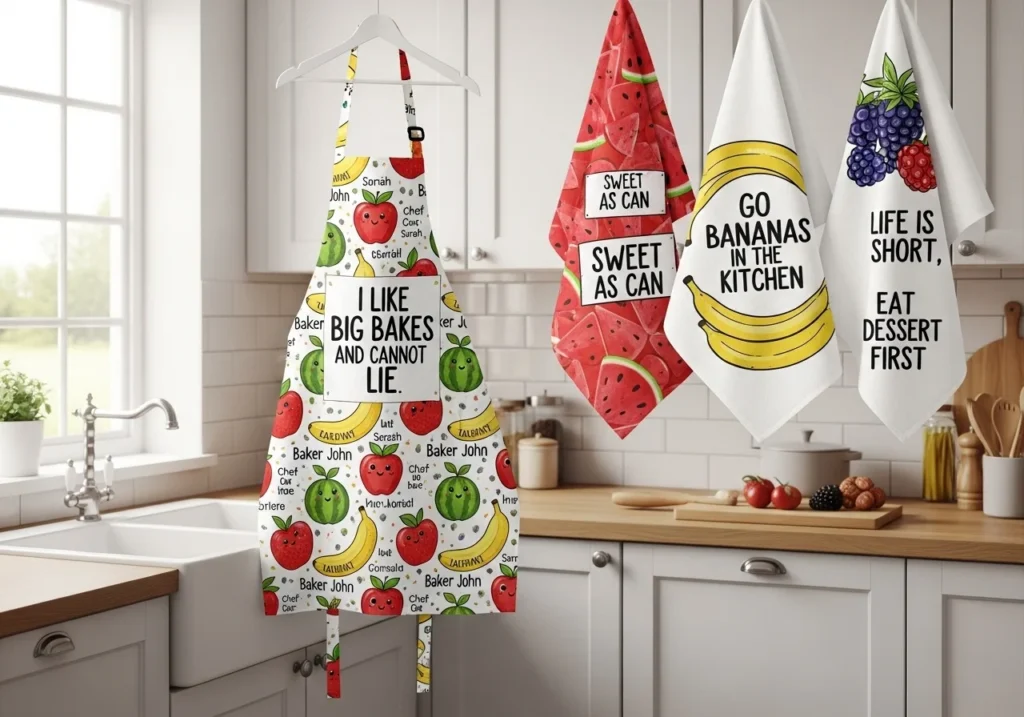
Personalized Towels
- Beach Towels: Design large beach towels with vibrant, tropical prints, names, or monograms.
- Kitchen Towels: Create decorative kitchen towels with custom patterns, quotes, or seasonal themes.
5. Art and Wall Hangings
Fabric Wall Art
- Canvas Prints: Use cotton canvas to create fabric wall art with high-resolution prints of landscapes, abstract art, or personal photographs.
- Tapestries: Design large fabric tapestries with intricate patterns, mandalas, or cultural artwork.

Inspirational Quotes
- Motivational Wall Hangings: Create inspirational quotes, affirmations, or meaningful phrases to decorate living spaces or offices.
Check out 5 Tips to Find the Perfect Canvas for Sublimation.
6. Seasonal and Themed Designs
Holiday Decorations
- Christmas Stockings: Design personalized Christmas stockings with names, festive images, or holiday greetings.
- Halloween Decorations: Create spooky-themed fabric decorations, banners, or pillow covers for Halloween.

Themed Apparel
- Sports Teams: Design apparel for local sports teams with logos, player names, and numbers.
- Festivals and Events: Create themed clothing and accessories for music festivals, parades, or community events.
FAQs
At Subli Genius Print, we’re here to help you master sublimation with quality products and expert tips. Explore our papers, inks, and accessories to start your next project, and share your creations with #SubliGeniusPrint.
What creative project are you excited to try with sublimation on cotton, and how do you plan to make it unique? Share your ideas with us in the comments below!
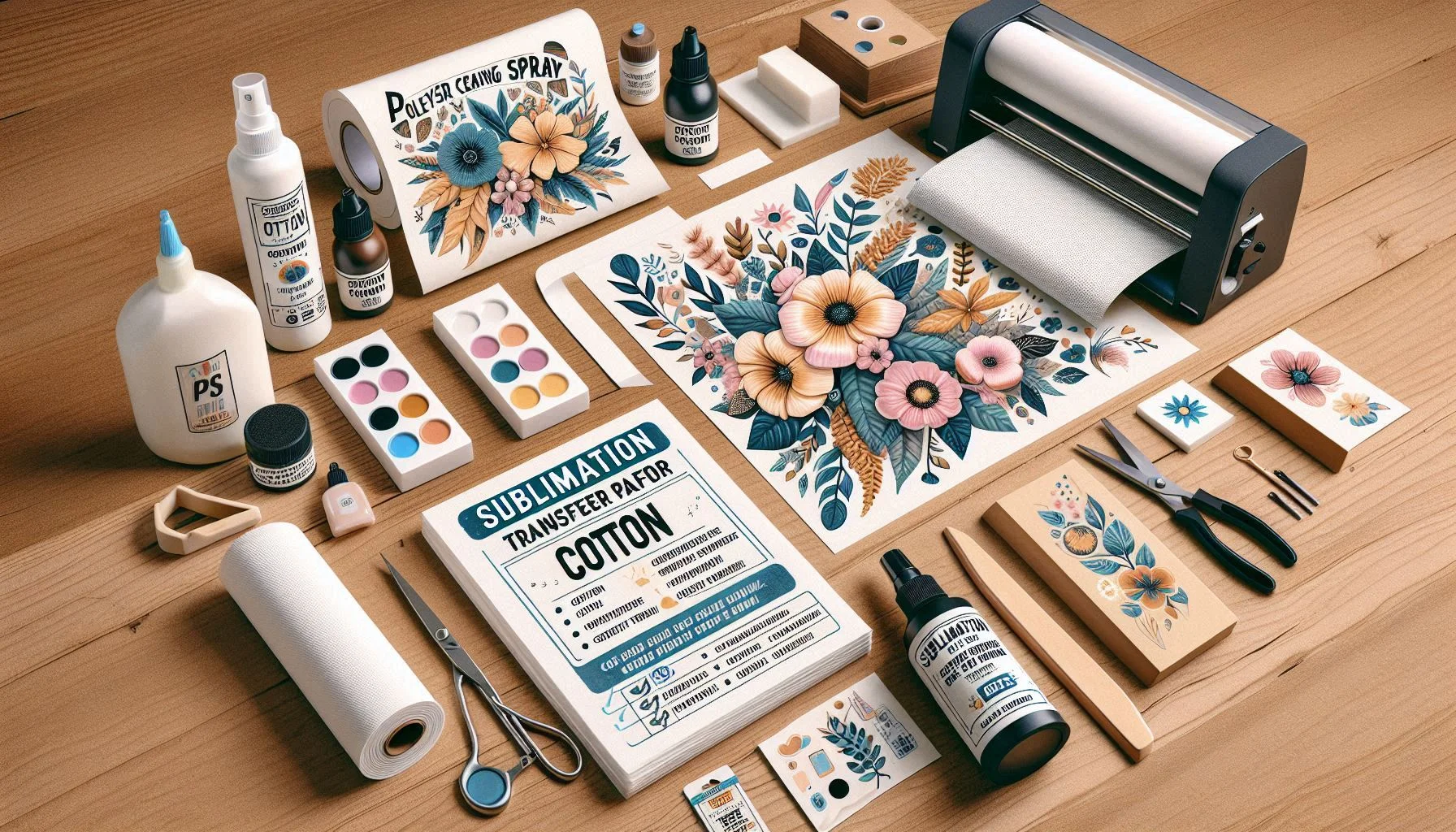
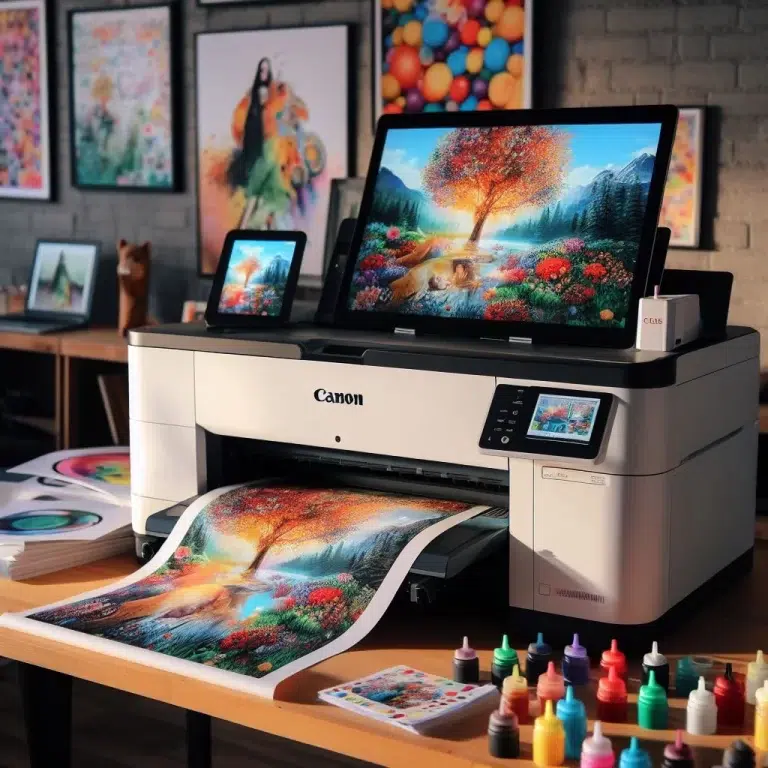

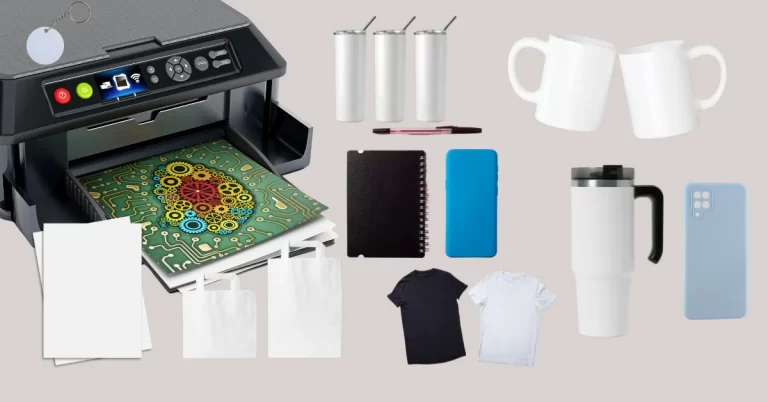
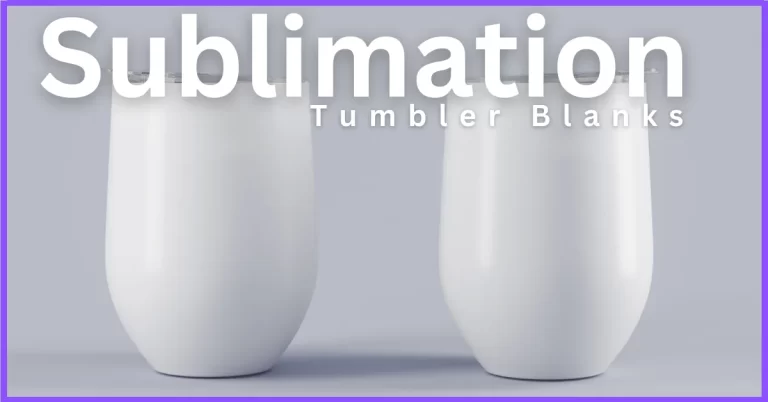
One Comment